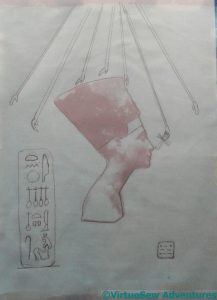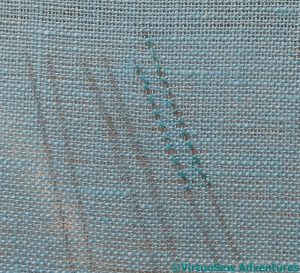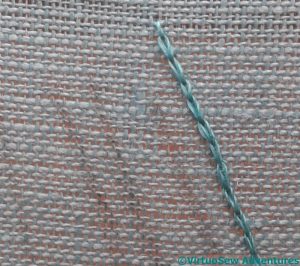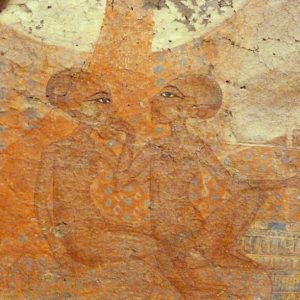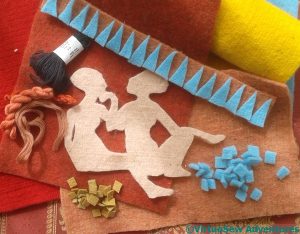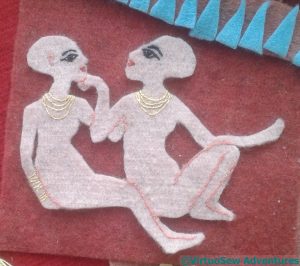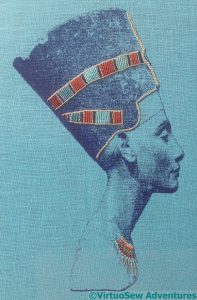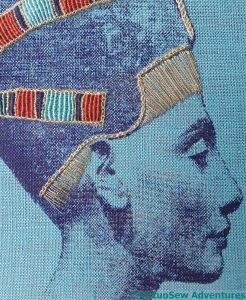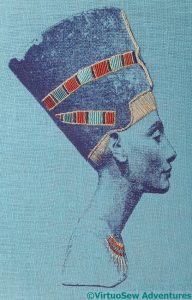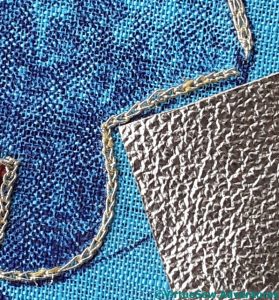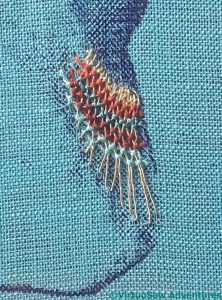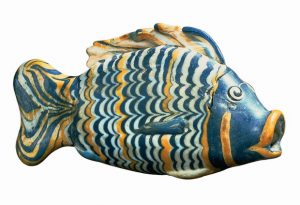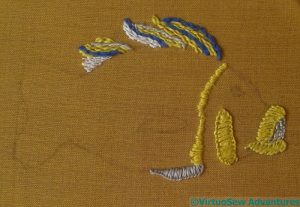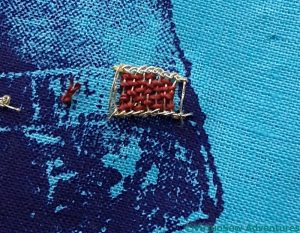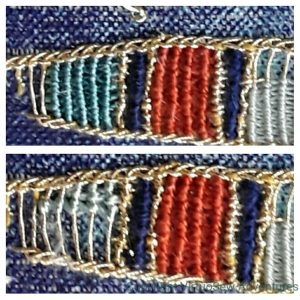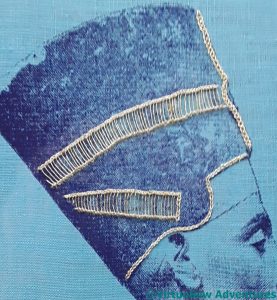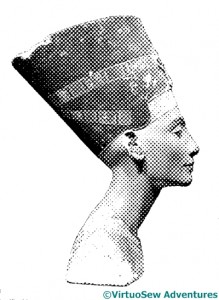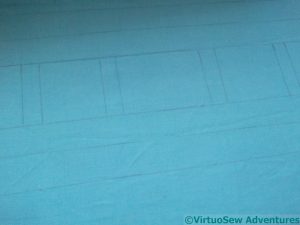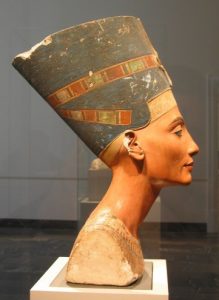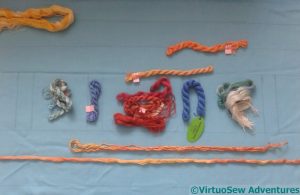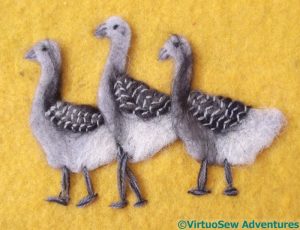Tag: Dreams of Amarna
The Head of Nefertiti – further details
I suddenly realised that I haven’t got any representations of the Aten in the panels. Considering that Akhenaten’s new, monotheistic devotion to the Aten actually created Amarna (Aketaten in his day), that is more than a little remiss of me. So the extra details I am planning for Nefertiti – shown here, drafted on tracing paper laid over the the print I didn’t use for stitching – begin to right that wrong.
I’ve drawn the rays of the Aten ending in little hands outstretched in blessing, as seen in many wall-carvings and paintings at Amarna. For some reason (research to be done…!) the hands nearest the noses of Nefertiti and Akhenaten often hold an ankh, so that is also included.
I’ve added in Nefertiti’s cartouche, although I think I may have drawn it too large for the design as a whole, and my own, which will include my initials in Morse Code, as this is a standalone companion piece.
I want the lines to be there, and yet not there, so I found some filament silk that I bought at Texere Yarns before they closed their store, and had a go with it, using reverse herringbone stitch, as I did for the contours of The Map of Amarna.
And it completely disappeared.
Oh dear!
So this is the next version, reverse chain stitch using a 2-into-1 twist. I’m much happier with that, although twisting the thread before I stitch with it does rather slow down the stitching part of it!
But still, here I am, stitching with hand-twisted thread, twisted by me. Never would fifteen-year-old me have believed I would be doing that!
If my Grandmama could see me now….
Two princesses
There’s a fresco of two of the daughters of Akhenaten and Nefertiti, which is quite well known, and indeed, was mentioned to me by the speaker, when I went to a lecture at the Egypt Exploration Society about the textiles in Tutankhamun’s tomb. I decided to have a go at representing this fragment using my embelllisher, to provide a companion piece for the three Amarna Geese I worked a while back.
Children in ancient Egypt – of whatever rank – appear to have run around naked much of the time, and with shaven heads. I’ll just have to get the outlines right….
I bought some more of the pre-felts I used for the Amarna Geese at “Sewing For Pleasure” in Birmingham, on the day I met up with Sue of Tortoiseloft blog.
Then I printed out the image I found online as large as I could and started planning my variation. It won’t, of course, be an exact reproduction of the fresco. It will be a sort of inlaid felt version of what I think might have been the real life inspiration for the scene.
Long-time readers may recall that I discovered with the Amarna Geese that embroidered details help to bring a scene to life, and at least if the embroidery is worked in wool, responds well to being needlefelted.
So after cutting out my two little princesses, in a single piece, I started to add details – lines to make sense of the bodies, the delicate eyes and eyebrows, the lips, and the necklaces. I’m very pleased with how they’ve turned out, because the felt doesn’t take pencil, so I was on my own – drawing with my needle.
Now I have to work out how to create the impression of the fabric backdrop and bench my two little princesses are sitting on….
The Head of Nefertiti – continuing progress
So this is where we left the Head of Nefertiti. the polychrome bands and the gold edges of the headdress are done, and I have worked a section of necklace.
I keep flip-flopping between feeling that that section of necklace is just right, and feeling that it really isn’t enough at all. I like the sense of a delicate flash of colour barely surviving the years, but at the same time, there’s an inner glitter-girl that wants to see a bit more than that..
So, while I think a little more about the necklace question, I thought I’d make another attempt at the browband. This time it is simply straight stitches, in a slightly finer thread than the rest of the gold stitching. It’s not perfectly regular, but, again, the slight unevenness evokes the damage of the years.
And besides, by now, you must know that regularity of stitching is not my forte!
So, again, I find myself at a pause.
I’m happy with the browband, I think, definitely happy with the polychrome bands, and the gold trim.
However, I’m still not sure whether I’m happy with the necklace.
Since my thought is to quilt a pattern into the background, I had best be certain that I’m happy before I start attaching padding and picking patterns!
More progress on The Head of Nefertiti
Once I had finished the polychrome bands, I sat back and looked at them. Using the darker shades of the colours in the darker part of the print helps to tie it all together and wrap the bands around the headdress.
I had a moment or two of concern, then decided that I would not, after all, ruin everything if I continued to add the other elements of the design that I had planned. There is always a moment or two of fear, especially when an early section has gone well!
The original bust shows something that looks like a browband of gold, fairly plain and flat. I fished out a piece of gold kid, but although the photograph doesn’t show it very well, the kid is the wrong colour (too pale, and not yellow enough) for the gold thread, so I have to think of something else.
*Thinks hard*.
Meanwhile, I thought I would experiment with the necklace, or collar. My thought was that, rather than do the whole thing, I would do a small section of it, to make sure that I maintain the feeling of an embroidery, and not a portrait of a portrait.
What I have done here is to make radiating stitches of the gold thread, and then use the same whipped filling stitch I used on the polychrome bands, but alternating them so there is a hint of a gold net underlying the collar.
I like this, but maybe I do need to do an entire collar’s worth.
*Thinks hard*. Again.
Nile Tilapia Fish
There is a glass vessel which frequently shows up in image searches relating to Amarna, a representation of a Nile tilapia fish. I saw it reconstructed by a modern glassworker in a recent programme about the art of Ancient Egypt presented by the British art critic Alistair Sooke. The glassworker said it was a somewhat unnerving technique to do, and with all his experience, and all his practice, he was never entirely confident of his results until a fish was finished,
That being the case, it seemed to me that as an example of the skill of the artisans of Amarna, the glass fish deserved to be included. I’ve found a public domain image to act as my source – and to show you what I’m talking about. I’m thinking of padding it slightly and attaching it to one of the background panels as a fish-shaped slip, rather than a rectangular patch, but we will have to wait and see what seems the right thing to do when I’ve finished.
I’m using some rather lovely vintage linen thread, bought at the recent “Sewing For Pleasure”, on a fine but sturdy cotton. I wanted something that would not require a backing, but I’m not sure that the fabric will be left to show, so I could have used some plain calico. The thread is wonderful to work with, strong, lustrous, and resilient. Much better than any linen thread I’ve ever worked with before – they’ve tended to be stiff, and a little “dead” in feel. This stuff is a delight!
So far, the stitches are blanket stitch, seed stitches, chain, stem, and feather stitch. I’m rather enjoying this!
The Head of Nefertiti – working with Silk
You will recall that I was rather underwhelmed by the effect of my first attempt at weaving the silk into the gold. Leaving the threads loosely packed to allow the gold to show through allows them to look untidy, and the colour is somehow a little flattened, not the rich, strong colour I wanted.
So I decided to work the whipped style of filling stitch instead. It creates a strong colour, something like a grosgrain ribbon, in fact.
I’m using primarily colours from the Mulberry Silks “Nefertiti” colour range (appropriate, don’t you think!), and I’m happy with the rusty red. The navy is actually a heavy perle type and I’m not sure where it came from. That works too.
The lightest colour, however, on the far right, is too fine. It produces too retiring an effect, and weakens the whole effect. So I tried one of the stranded silks from Thistle Threads (lower example, left), and wasn’t convinced by that, either.
This looks better. In fact the two light blue-greens are different, although that isn’t as clear in this photo as I might have liked. They aren’t as green as I would have liked, but I’m reasonably happy. If I decide to redo them, I may have to redo the whole thing, as the unpicking earlier on has left the Ladder Stitch a bit floppy.
The Head of Nefertiti – Goldwork Completed
There are small elements of goldwork which I am planning to work last, but most of it, I wanted to put in place first, so that I can be sure that the whole thing remains in balance.
As I’ve mentioned, the framework for the silk is in Ladder Stitch – the whole of the first section redone, as I threatened.
The narrow line around the base is in reverse chain stitch (much easier to work in a frame than the ordinary chain stitch). The coloured bust suggests a gilded inner section for the headdress, and I have yet to decide how to represent that. Maybe gold kid?
The ornament on the front of the headdress looks rather heavier and thicker than the other lines, so I’ve worked it in Hungarian Braided Chain Stitch. I’m a little disappointed with it at present, and wondering whether I need to pick a still heavier stitch – such as the dreaded (not any more!) Plaited Braid Stitch. I’ll decide, I think, when I’ve completed the rest of it.
So, on to the silkwork. I had a previous, failed print to experiment with, and I’m just as glad I did.
I’m rather underwhelmed by this effect, with the silk woven through the gold. I thought it would allow a subtle glint of gold, but in the end it has simply undermined the effect of the silk. Hmm…
Adventures with a screen print
It occurred to me recently that when I finally finish the Dreams of Amarna panels I will probably want to exhibit them somewhere – displaying them at home would require a complete redesign, including moving walls! – and that, however large or intricate they may be, two panels do not an exhibition make.
At the same time, however, I’d had an idea for a design for which I could apply the combined silk and gold stitches of the Tudor Rose, and furthermore, that might allow me scope, later, to play with some of the mixed media techniques that are available…
So I went rummaging among the assorted copyright-free and Creative Commons images on the web (my goodness, there are thousands!) and found a photo of the famous painted head of Nefertiti which is in the Berlin Museum. Then with some cropping and processing, from a photo of the bust in its case it became a plain headshot with no background, rendered in the style of an old-fashioned newsprint picture. An email conversation and a payment later, that image had been turned into a custom-made Thermofax screen…
At which point, all the simplicity fell over. I’ve actually done four screen prints on the faience-coloured linen, and about three on sandy coloured linen, and none of them was good enough for my purposes. I’m not sure whether the screen is too detailed for the fabric or whether it is simply my technique that is faulty.
So I guess I just need to try harder!
Suddenly Re-Thinking
I bought the turquoise pashmina with the intention of working one of the Stitch-Off designs on it, but as I was playing around with colours, I had a sudden thought…
It’s an absolutely gorgeous faience colour, so why don’t I choose colours inspired by my Dreams of Amarna project. And while I’m about it, create a design inspired by those patterns I’ve been playing with…
In the end I’ve decided to take my inspiration from that famous bust of Nefertiti, discovered by Ludwig Borchardt in 1912. It would therefore have been known to Mary Chubb. This picture is a Creative Commons-licensed image I found online, but in this particular case, all I wanted it for was to check on the distribution of small and large segments and colours.
So that’s garnet or carnelian coloured sections, lapis-coloured sections and jade-coloured sections, all outlined in gold. In this case, I don’t want to use metallic thread, so the gold will be rendered in golden-yellow.
I’ve been working on making a design printing and transferring board, so I pinned out the end of the pashmina I want to embellish on the board, and simply drew straight lines as a guide.
Then I had a wonderful time fishing out jewel-coloured silk threads.
All I need now is some idea of the stitches I intend to use!
Amarna Geese – stage 2
I’ve started adding more detail with needle and thread. The chevron pattern, the eyes, and the detail on the beak are all made using straight stitches in single strands of Appletons wool. I can’t think where I got a whole series of greys, unless it’s from hand-me-downs. I’m glad I have them now, but it isn’t a colour I much like and I can’t imagine going out and buying them!
For the legs, I have used three different colours of wool in the needle. I can see that for all my staring at photographs and trying to sketch, I’ve not really got a clear or accurate idea of the details of goose anatomy! And somehow, for all my care in placing the cut out felt geese, they’ve ended up attached in not-quite-the-right place.
Still, let’s not despair.
I’ve also added some ground below the the geese. Three strands of different colours of wool, again. I did a sort of loopy knot stitch crossed with a split stitch, which I couldn’t reproduce if I tried. But it produces a very good broken-ground effect, so as long as I don’t decide I need more ground, we’ll be fine.
Then I sat down at the embellisher and tried to blend the fabrics together. This meant quite heavy embellishing, but fortunately the fabrics are none of them dense, so there was room for the fibres to mingle.
When I noticed that the legs weren’t getting caught in, I twisted some more threads around them. That’s better.
Then another pause. Do I add leaves, to match my vague memory, or shall I leave well alone?

